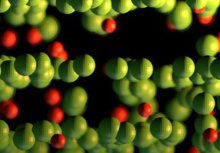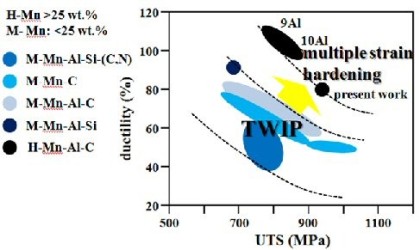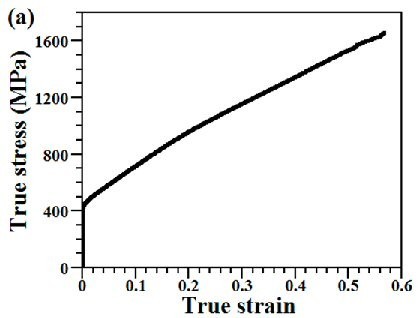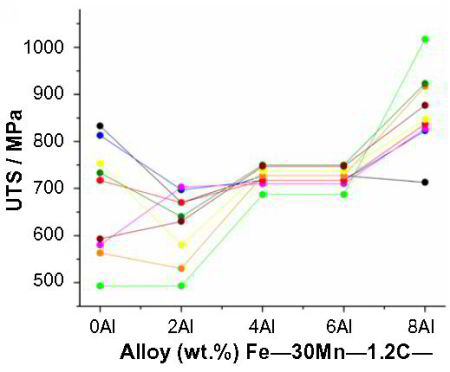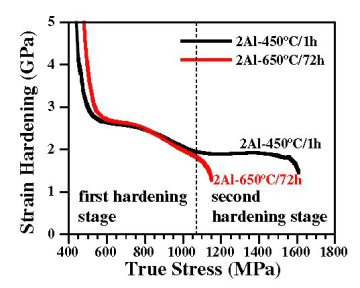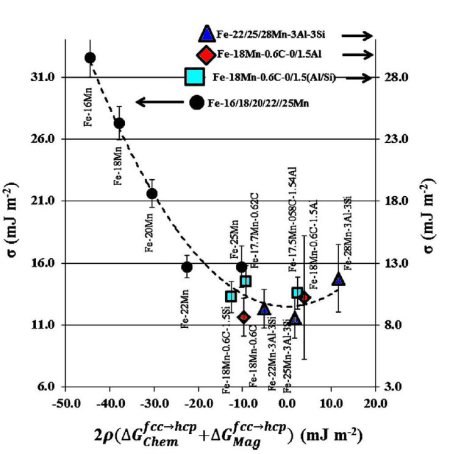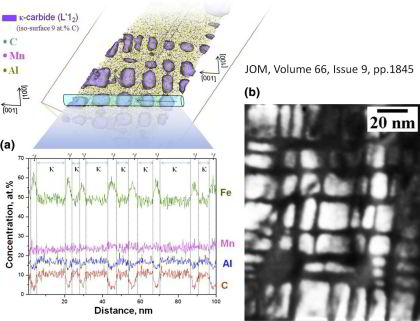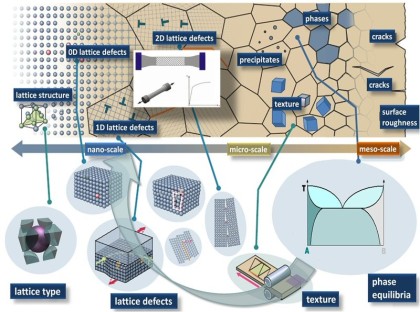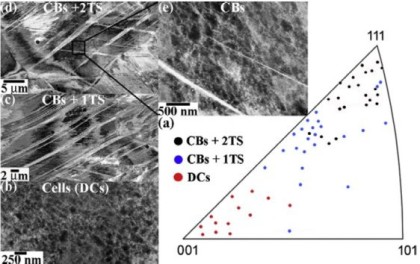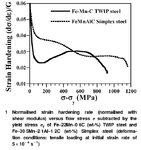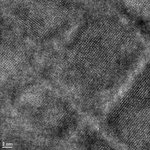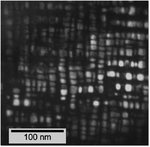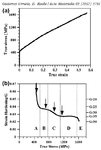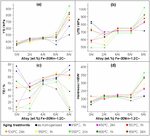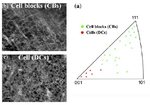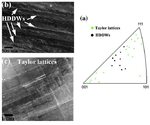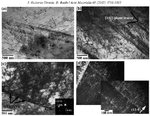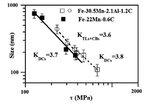TRIPLEX Steels
Steels containing high amounts of manganese (Mn), aluminium (Al) and carbon (C) are sometimes also referred to as “Triplex” steels. These materials exhibit low mass density, high strength and excellent ductility in comparison with established steels for structural engineering applications. We derive this attractive property profile from an austenitic or austenitic/ ferritic matrix, both stabilized and strengthened by alloying iron (Fe) with Mn (18–28 wt.%) and C (0.7–1.2 wt.%), together with Al addition (3–12 wt.%) for low specific weight and improved corrosion resistance. Profound changes in the mechanical properties can be achieved by ageing the material after solution annealing and quenching. More specifically, kappa-Al(Fe,Mn)3C carbides were found to precipitate from the matrix during ageing, growing from C-enriched areas, most probably formed via spinodal decomposition during quenching. The development of Fe–Mn–Al–C alloys involves simultaneous investigation of the respective microstructural microstructural phenomena by high resolution characterisation techniques such as atom probe tomography (APT) and transmission electron microscopy (TEM).
Fe-Mn-Al-C : weight reduced steels
Combinatorial design of steels: We introduce an approach to the compositional and thermo-mechanical design and rapid maturation of bulk structural materials.
Acta Materialia 60 (2012) 4950-4959
H. Springer, D. Raabe
Acta-Mater-2012-RAP--30Mn-triplex-steels[...]
PDF-Dokument [1.3 MB]
Increased efficiency in the development of novel metallic structural materials is a key to providing fundamental and applied alloy solutions in the fields of energy,
mobility, health, infrastructure and safety. Examples of the associated basic metallurgical questions are alloy- and processing- sensitive changes in complex strain
hardening phenomena. In high strength steels these are often associated
with displacive transformations, such as twinning and transformation-induced plasticity (TWIP and TRIP), which can be tuned through variations in the stacking fault energy and
microstructure. Associated engineering issues are systematic analysis of the corresponding trends in texture evolution, sheet forming and damage parameters, joining behaviour, hydrogen
susceptibility or fatigue. In thin film systems, in which combinatorial high throughput methods were invented and established, substantial progress has been made in a number of
materials design fields, such as shape memory alloys, MAX phases and shape change materials [1–6]. Such combinatorial methods have mostly been applied to the design of
functional materials, where, typically, the intrinsic composition-dependent properties dominate over the relevance of the microstructure. In structural alloys, on the other hand, the
relevant length scales that determine the mechanical behaviour are parameters such as grain size, texture, precipitate dispersion and topology and the dislocation cell structure, to
name but a few. The correlation lengths associated with such lattice defects are usually of the order of several nanometres to multiple micrometres, hence, they
usually exceed the dimensions accessible in thin films. This means that the mechanical properties of structural materials are not only determined by their chemical composition, but to
a large extent by the microstructure, which in turn is
greatly influenced by the thermo-mechanical treatments (TMTs) applied after synthesis [7–9]. Consequently, the current conventional approach for the experimentally guided development
of metallic structural materials typically consists of a number of iterative loops that include the following basic steps: Bulk casting of a single composition charge, hot and/or cold
deformation (e.g. conventional or thermo-mechanical rolling), heat treatment (such as quenching, partitioning or ageing), machining of tensile specimens and mechanical testing.
Coupled with the wide range of possible chemical compositions and different TMT setups, this kind of incremental trial and error approach typically provides robust mechanical data on
novel alloys [10,11], however, it is often too time consuming for a more efficient investigation and the maturation of complex alloy systems as a function of composition, TMT
processing and microstructure.
Thus it becomes clear that the development of novel and more efficient high throughput methods for the bulk synthesis, TMT processing and following investigations of structural
materials is of great interest. It is aimed at drastically
increasing both the scientific and engineering efficiency by reducing the time between an alloy design idea and final evaluation of the material’s mechanical and microstructural
properties from several weeks or even months down to hours. Materials exhibiting desirable properties (“hits”) can be readily selected from the investigated composition/TMT matrix and
then scaled up via
conventional methods for more detailed investigations based on the information collected. Rapid and systematic screening of prototype alloys and TMT setups, ideally employed in concert
with theory-based, alloy-sensitive simulation
methods [12–15], thereby allows the efficient and knowledge-based design of structural materials. Steels containing high amounts of manganese (Mn), aluminium (Al) and carbon (C) were
here chosen as an example material system to utilize the novel approach outlined above. Also referred to as “Triplex” steels, these materials exhibit a low mass density, high strength
and excellent ductility
in comparison with established steels for structural engineering applications [10,16,17]. The authors derived this attractive property profile from an austenitic or
austenitic/ ferritic matrix, both stabilized and strengthened by alloying iron (Fe) with Mn (18–28 wt.%) and C (0.7–1.2 wt.%), together with Al addition (3–12 wt.%) for low
specific weight and improved corrosion resistance [10,18–20].
Profound changes in the mechanical properties can be achieved by ageing the material after solution annealing and quenching. More specifically, j-Al(Fe,Mn)3C carbides were found to
precipitate from the matrix during ageing, growing from C-enriched areas, most probably formed via spinodal decomposition during quenching [17,21,22]. The further development of
Fe–Mn–Al–C alloys must involve simultaneous investigation of the respective microstructural
phenomena by high resolution characterisation techniques such as atom probe tomography (APT) and transmission electron microscopy (TEM). Such techniques, however, require increased
efforts in sample preparation and experimental procedures [23–26] and are, therefore, preferably applied only to those compositions and microstructures that reveal the most interesting
characteristics or properties. The wide range of possible chemical compositions
in the Fe–Mn–Al–C quaternary system, combined with a large matrix of possible TMT routes (especially ageing time and temperature), justifies the high level of motivation for the
development and use of rapid alloy prototyping (RAP) techniques as an efficient tool for structural materials development.
Hence, the objective of this work was to present a new approach to the rapid investigation of bulk metallic structural materials, whereby the mechanical properties of a group of
alloys systematically varied in terms of chemical
composition and the imposed TMT treatments can be evaluated simultaneously and thus with a higher throughput than with conventional methods and step by step iteration of these
parameters. The approach is referred to as RAP.
As an exemple here we study a novel group of 30Mn–1.2C steels in terms of the effects of varying Al content and different ageing conditions on the microstructure and properties. Selected
results are directly compared with data
obtained from conventionally synthesised and processed samples to validate the approach.
Multistage strain hardening through dislocation substructure and twinning in a high strength and ductile weight-reduced
Fe–Mn–Al–C steel (TRIPLEX)
2012-Acta FeMnAlC.pdf
PDF-Dokument [1.8 MB]
Materials Science and Technology 2014 VOL 30 NO 9 1099;
We introduce the alloy design concepts of high performance austenitic FeMnAlC steels, namely, Simplex and alloys strengthened by nanoscale ordered k-carbides. Simplex steels are characterised by an outstanding strain hardening capacity at room temperature. This is attributed to the multiple stage strain hardening behaviour associated to dislocation substructure refinement and subsequent activation of deformation twinning, which leads to a steadily increase of the strain hardening. Al additions higher that 5 wt-% promote the precipitation of nanoscale L912 ordered precipitates (so called k-carbides) resulting in high strength (yield stress y1?0 GPa) and ductile (elongation to fracture 30%) steels. Novel insights into dislocation–part
Materials Science Technology 2014 low de[...]
PDF-Dokument [319.9 KB]
I. Gutierrez-Urrutia, D. Raabe
Scripta Materialia 68 (2013) 343-347
Influence of Al content and precipitation state on the mechanical behavior of austenitic high-Mn low-density steels
Scripta Materialia 68 (2013) 343–347-Al-[...]
.pdf Datei [739.9 KB]
The development of advanced lightweight steels with superior mechanical properties is the ultimate goal for structural applications in many industrial sectors, in particular in the
automotive industry. These steel grades allow
the manufacture of lightweight crash-resistance car body structures, leading to safer cars and a considerable reduction in fuel consumption and, hence, reduced CO2 emissions. In recent
years, two main steel grades have been explored, namely, ferritic Fe–Al and austenitic high-Mn steels. Fe–Al alloys with an Al content up to 9 wt.% and additions of microalloying
elements such as Ti, Nb and V (<0.03 wt.%) have a reduced density of 7 g cm3 and exhibit a good strength-ductility balance at room temperature (ultimate tensile strength
(UTS): 500 MPa; elongation: 35%). The strong influence of Al content on the underlying strengthening and deformation mechanisms as well as on ordering phenomena makes the Fe–Al
system a challenge for alloy designers. High-Mn steels, with Mn content between 20 and 30 wt.% and additions of Al up to10 wt.% and C between 0.5 and 1.8 wt.%, have been recently
considered as promising lightweight structural steels. These steel grades exhibit outstanding combinations of strength and ductility (UTS: 1.0–1.5 GPa; elongation: 30–80%), as well as
a reduced specific weight.
We investigate the strain hardening of two austenitic high-Mn low density steels, namely, Fe–30.5Mn–2.1Al–1.2C and Fe–30.5Mn–8.0Al–1.2C (wt.%), containing different precipitation states. The strain hardening of the alloy with low Al content is attributed to dislocation and twin substructures. The precipitation of intergranular M3C-type carbides strongly influences the fracture mode. We associate the strain hardening behavior of the alloy with high Al content to the precipitation of shearable nanosized j-carbides and their role in the development of planar dislocation substructures.
More specific here we investigate the strain hardening of two austenitic high-Mn low density steels, namely, Fe–30.5Mn–2.1Al–1.2C and Fe–30.5Mn–8.0Al–1.2C (wt.%), containing different precipitation states. The strain hardening of the alloy with low Al content is attributed to dislocation and twin substructures. The precipitation of intergranular M3C-type carbides strongly influences the fracture
mode. We associate the strain hardening behavior of the alloy with high Al content to the precipitation of shearable nanosized j-carbides and their role in the development of planar dislocation substructures.
Acta Materialia 68 (2014) 238-253
D.T. Pierce, J.A. Jimenez, J. Bentley, D. Raabe, C. Oskay, J.E. Wittig
The influence of manganese content on the stacking fault and austenite/e-martensite interfacial energies in Fe–Mn–(Al–Si) steels investigated by experiment and theory
Acta Materialia 68 (2014) 238 TWIP steel[...]
.pdf Datei [1.0 MB]
The stacking fault and interfacial energies of three transformation- and twinning-induced plasticity steels (TRIP/TWIP) (Fe–22/25/ 28Mn–3Al–3Si wt.%) were determined by experimental and
theoretical methods. Analysis of Shockley partial dislocation configurations in the three alloys using weak-beam dark-field transmission electron microscopy yielded stacking fault energy (SFE)
values of 15 ± 3, 21 ± 3 and 39 ± 5 mJ mÿ2 for alloys with 22, 25 and 28 wt.% Mn, respectively. The experimental SFE includes a coherency strain energy
of 1–4 mJ mÿ2, determined by X-ray diffraction, which arises from the contraction in volume of the stacking fault upon the face-centered cubic (fcc) to hexagonal close-packed (hcp) phase
transformation. The ideal SFE, computed as the difference between the experimental SFE and the coherency strain energy, is equal to14 ± 3, 19 ± 3 and 35 ± 5 mJ mÿ2, respectively. These SFE values
were used in conjunction with a thermodynamic model developed in the present work to calculate the free energy difference of the fcc and hcp phases
and to determine a probable range for the fcc/hcp interfacial energy in the three Fe–Mn–(Al–Si) steels investigated. In addition, the interfacial energies of three Fe–18Mn–0.6C–0/1.5(Al/Si) TWIP and
five Fe–16/18/20/22/25Mn binary alloys were also determined from experimental data in the literature. The interfacial energy ranged from 8 to 12 mJ mÿ2 in the TRIP/TWIP steels and from 15
to
33 mJ mÿ2 in the binary Fe–Mn alloys. The interfacial energy exhibits a strong dependence on the difference in Gibbs energy of the individual fcc and hcp phases. Accordingly, an empirical description
of this parameter is proposed to improve the accuracy of thermodynamic SFE calculations.
JOM, Volume 66, Issue 9, pp.1845-1856
D. RAABE, H. SPRINGER, I. GUTIERREZ-URRUTIA, F. ROTERS, M. BAUSCH, J. -B. SEOL, M. KOYAMA, P. -P. CHOI,and K. TSUZAKI
Alloy Design, Combinatorial Synthesis, and Microstructure–Property Relations for Low-Density Fe-Mn-Al-C Austenitic Steels
JOM density reduced steels overview 2014[...]
.pdf Datei [3.7 MB]
Here we present recent developments in the field of austenitic steels with up to 18% reduced mass density. The alloys are based on the Fe-Mn-Al-C system. Here, two steel types are addressed. The first one is a class of low-density twinning-induced plasticity or single phase austenitic TWIP (SIMPLEX) steels with 25-30 wt.% Mn and <4-5 wt.% Al or even <8 wt.% Al when naturally aged. The second one is a class of kappa-carbide strengthened austenitic steels with even higher Al content. Here, kappa-carbides form either at 500-600°C or even during quenching for >10 wt.% Al. Three topics are addressed in more detail, namely, the combinatorial bulk high-throughput design of a wide range of corresponding alloy variants, the development of microstructure-property relations for such steels, and their susceptibility to hydrogen embrittlement.
Combinatorial development of TRIPLEX weight reduced steels
Raabe-Materials-Genome-workshop-Vail-201[...]
PDF-Dokument [2.2 MB]
High manganese steels have an outstanding combination of strength and ductility owing to their high strain hardening capacity. They are austenitic, i.e. face-centered cubic (fcc) alloys, with a
high Mn content (typically between 20 and 30 wt.%) and additions of elements such as carbon (<1 wt.%), silicon (<3 wt.%), or aluminum (<10 wt.%). High-Mn steels exhibit different hardening
mechanisms which have been commonly interpreted in terms of the stacking fault energy. Several authors have considered the role of clustering of carbon and manganese atoms on strain hardening, in
particular, on the occurrence of serrated flow. Some studies have recently addressed the influence of short range ordering (SRO) on strain hardening. These authors suggest a strain hardening
parameter (the so-called theoretical ordering index, TOI) that is related to the SRO strengthening mechanism. Among the different strain hardening mechanisms, twinning-induced plasticity (TWIP) has
received much interest due to the good mechanical compatibility between dislocation slip and the dynamically refined twin interfaces compared to other chemical / crystallographic interfaces (for
instance, epsilon-martensite). As twin interfaces act as strong obstacles to dislocation glide, microstructure refinement by deformation twinning increases the strain-hardening
rate. The TWIP effect is therefore determined by the twinning kinetics, more specifically by the twinning rate and the average twin spacing.
Recently, a new hardening mechanism has been proposed in high-Mn steels, namely, microband-induced plasticity (MBIP). This mechanism has been reported in Fe–Mn–Al–C alloys with high stacking fault energy (50–90 mJ/ m^2). These alloys exhibit an outstanding combination of strength (ultimate tensile strength of 900 MPa) and ductility (ca. 100% elongation to fracture). Furthermore, the high aluminum content (up to 10 wt.%) renders these steels lightweight alternatives to conventional high strength structural materials. MBIP has been ascribed to the formation of microbands and their role as an individual strain hardening mechanism. The microbands were described as in-grain narrow shear zones that are delimited by geometrically necessary boundaries. However, upon deformation different types of dislocation substructures such as highly dense dislocation walls (HDDWs) and Taylor lattices have been observed as well. Up to now no detailed quantitative characterization of the underlying kinetics of the substructure evolution and their correspondence to the stress–strain and strain hardening evolution in the FeMnAlC system have been performed. Specifically, the contributions of the different types of dislocation substructures, namely, HDDWs, Taylor lattices and microbands, to the excellent strain hardening capacity of FeMnAlC steels are still unclear. Therefore, the present study has the following aims. First, we study in detail the contribution of the evolving dislocation substructure and its effect on strain hardening.
Specifically, we aim at clarifying the role of microbanding in FeMnAlC steels. Second, we explore the various suggested strain hardening mechanisms, namely, microband hardening through dislocation
substructure pattering (MBIP) and deformation twinning (TWIP), as well as their interactions, in order to better understand the strain hardening behavior of FeMnAlC steels. For these purposes, we
have selected a Fe–30.5Mn–2.1Al–1.2C (in wt.%) alloy in solid solution state. We performed a complete quantitative characterization of the underlying deformation structure by transmission electron
microscopy (TEM) and electron channeling contrast imaging (ECCI). The ECCI technique combined with electron backscatter diffraction (EBSD) allows us to characterize the deformed structure at a wide
field of view in the scanning electron microscope (SEM) with a better dislocation and interface contrast than the basic ECCI technique. The contribution of the so characterized dislocation and twin
substructures to the strain hardening is analyzed in terms of the dislocation mean free path approach.
Viewpoint Paper: Scripta Materialia 68 (2013) 343–347:
Here we investigate the strain hardening of two austenitic high-Mn low density steels, namely, Fe–30.5Mn–2.1Al–1.2C and Fe–30.5Mn–8.
Scripta-Mater-68 (2013) 343–weight-reduc[...]
PDF-Dokument [721.1 KB]
